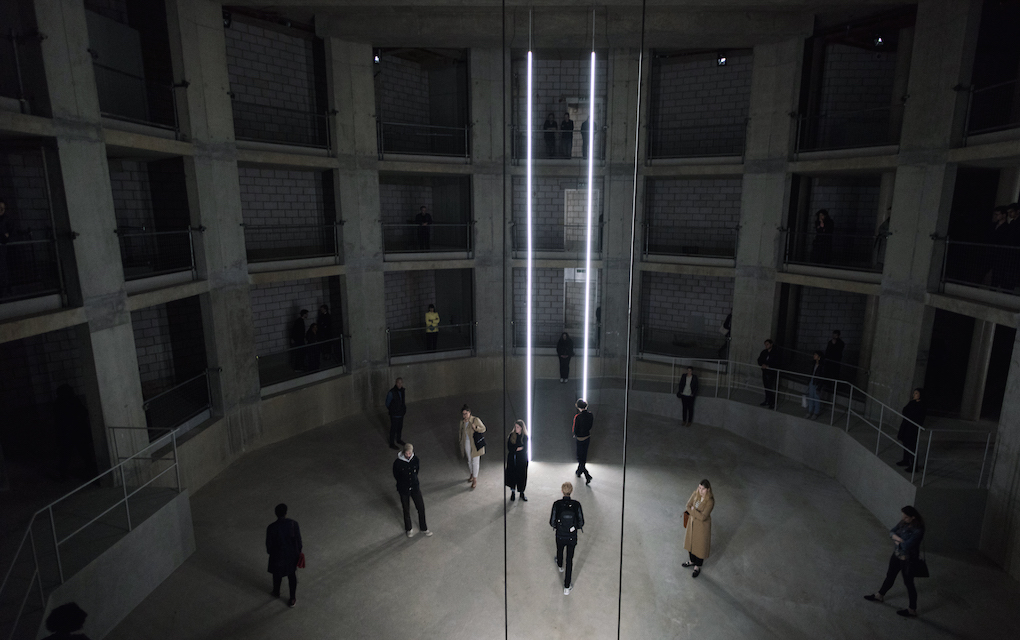What a superb location for a performance! The flats on the north-east corner of Islington Green back onto a crummy atrium from which a staircase leads down to a vaulted, concrete pit (pictured below). A cross between a car park and a bull ring, or a subterranean version of a de Chirico painting, this huge chamber reminded me of the stark designs of the Italian modernist, Aldo Rossi.
Peering over the topmost balustrade, one sees silent figures entering the subterranean space through portals created with slender rods of light. Most are dressed in black; they are professional mourners flown in from all over the world by American artist Taryn Simon to perform their lamentations in this dismal place, which feels like an anti-chamber to Hell.
 They move to various locations on the levels below and, at the sudden prompting of wooden clappers, begin their incantations. Collectively their voices produce a raucous cacophany that draws you inexorably down to the lower levels to discover the mourners standing or sitting on minimalist sets dotted around the periphery. Each designated space is like a shrine, in which you stand very close to performers who assiduously ignore you.
They move to various locations on the levels below and, at the sudden prompting of wooden clappers, begin their incantations. Collectively their voices produce a raucous cacophany that draws you inexorably down to the lower levels to discover the mourners standing or sitting on minimalist sets dotted around the periphery. Each designated space is like a shrine, in which you stand very close to performers who assiduously ignore you.
I expected to be deeply moved by their keening, but in the absence of any bodies or the ritual trappings of a funeral, the experience is surprisingly abstract. The laments are in languages as various as Ghanaian, Kurmanji, Wayuu, Darghin and Greek. But I began to notice that, despite being in different languages and coming from diverse cultural backgrounds, these strangely beautiful recitations share many similar rhythms and cadences.
A blind man from Ecuador (pictured above right, Hugo Anibal) plays an accordion while singing an almost jaunty lament; most are very solemn, though, and contain suggestions of anger as well as grief and loss. Dressed in white, a Han Chinese woman kneels before an altar-like table, gesticulating dramatically as she wails into a microphone. Whereas this feels like a performance, the others are far more inscrutable. Two women from Venezuela (main picture) hide themselves beneath patterned cloths, while the Ghanaians keep their eyes tightly shut as they honour the memory of the deceased. Back home, their ceremony might continue for several days, but here everything is over in just half an hour.
The silence that ensues is sudden and profound. The mourners melt back into the darkness leaving one to confront the emptiness that follows such an intensity of sound and to absorb the melancholy of the cavernous space. For An Occupation of Loss is as much a sculptural and architectural experience as it is an aural and emotional one.  Thank you to Artangel, who commissioned this remarkable event and discovered this liminal space so far removed from life above ground. A booklet records the hoops they had to jump through in order to obtain visas for the mourners. Descriptions written for the Home Office by various academics offer useful insights into the social and religious significance of the laments and provide an imaginative alternative to an orthodox catalogue. Powerful stuff!
Thank you to Artangel, who commissioned this remarkable event and discovered this liminal space so far removed from life above ground. A booklet records the hoops they had to jump through in order to obtain visas for the mourners. Descriptions written for the Home Office by various academics offer useful insights into the social and religious significance of the laments and provide an imaginative alternative to an orthodox catalogue. Powerful stuff!









![SEX MONEY RACE RELIGION [2016] by Gilbert and George. Installation shot of Gilbert & George 21ST CENTURY PICTURES Hayward Gallery](/sites/default/files/styles/thumbnail_125_x_125_/public/mastimages/Gilbert%20%26%20George_%2021ST%20CENTURY%20PICTURES.%20SEX%20MONEY%20RACE%20RELIGION%20%5B2016%5D.%20Photo_%20Mark%20Blower.%20Courtesy%20of%20the%20Gilbert%20%26%20George%20and%20the%20Hayward%20Gallery._0.jpg?itok=3oW-Y84i)





Add comment